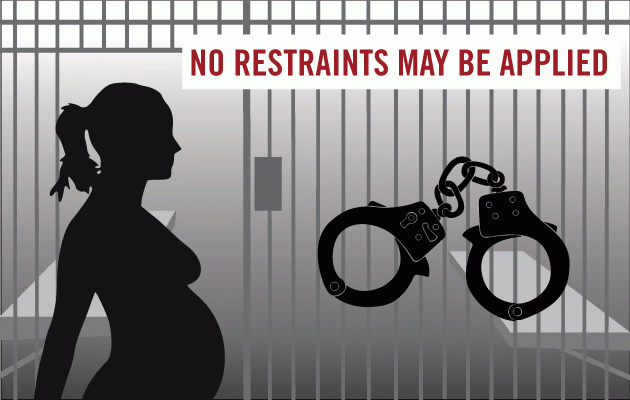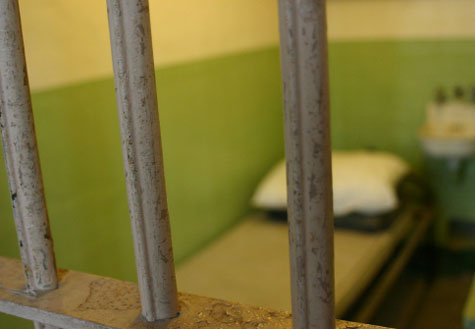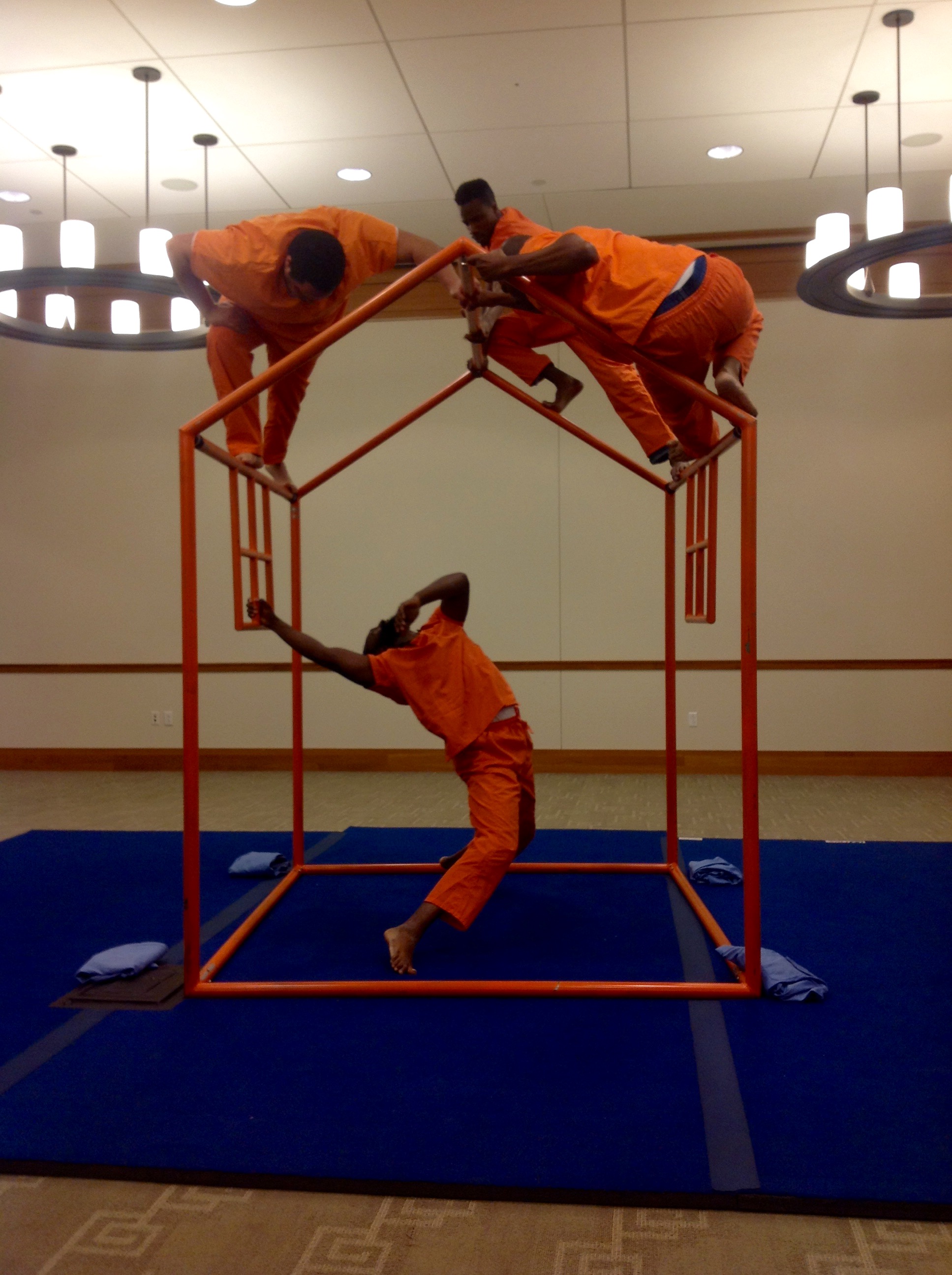 Image via ColorLines
Image via ColorLines
“It blows my mind that I have to sign a law for that,” Massachusetts former governor Deval Patrick said in May 2014, after he signed into law the Act to Prevent Shackling and Promote Safe Pregnancies for Female Inmates in Massachusetts. The law was groundbreaking in that it both protected women’s health behind bars and forbid shackling of pregnant prisoners.
Currently 29 states still allow women behind bars to be shackled during birth. This occurs, in spite of the fact, reported by the Women’s Media Center (WMC) in March 2015, that “this practice has been condemned by many medical and international humanitarian organizations, including the American Medical Association, Amnesty International, and the United Nations Committee Against Torture.” WMC added that it wasn’t until 2000 that merely “one state—Illinois—enacted legislation restricting the use of restraints.”
According to the Massachusetts Anti-Shackling Coalition, the 2014 Massachusetts law went beyond banning shackling and aimed to insure a “safe healthy pregnancy, birth experience and postpartum recovery, including prenatal care, adequate nutrition, and support during labor and birth.” So would it blow Governor Patrick’s mind, if he were to learn that indeed the law to support pregnant prisoners is not being followed in many of the places we incarcerate women throughout the state?
Barbaric restraints that never should have been used in the first place are still in use. According to Judge Nancy Gertner, in a recent op-ed in the Boston Globe, shackles and waist chains for pregnant women are “unconstitutional…a violation of the Eighth Amendment’s ban on cruel and unusual punishment.” Vans without seat belts are still employed to transport women to and from jails. The statute is clear: no restraints except for handcuffs up front, but facilities are not following the law, in spite of the fact that statute forbids shackles “except in extraordinary circumstances,” and as Judge Gertner clarified, “even then, without leg or waist restraints.” Healthy pregnancies, how are they faring behind bars? Early results seem to indicate that violations of the statute on that front are also alive and well. Healthy diets and suitable clothing and undergarments are not being provided.
Two major advocacy groups, Prisoners’ Legal Services (PLS) and Prison Birth Project (PBP) interviewed women who were pregnant, and some who gave birth in the last year, since the law went into effect. A few of their experiences, reported anonymously, show the ways the law is not being followed:
- “I took a shower after the birth and they put me back in bed and shackled me to the bed by my left ankle. I said it was against the law, but the female C.O. said she had never heard of that. She called the jail and whoever she talked to also said they never heard of it. So I stayed shackled to the bed.”
- “It was very uncomfortable in the back of the vans. You’d slide everywhere, it was a very bumpy ride. It was scary. I would sometimes get cramps on those rides. Me and another pregnant girl who was having twins would talk about whether we’d go into labor in the van itself. We would joke around as a way to deal with how awful it was.”
- “I hate being this pregnant, being hungry and only having access to an extra cheese sandwich. Knowing what I do about being pregnant I know I should be eating more fresh vegetables.”
Lauren Petit, an attorney from PLS, in an interview, said that when the law was passed, jails and Department of Correction (DOC) prisons received the language of the statute—no more, no less. They were to do their own implementation, and by “they”—all the county facilities that transport women, like Essex, and those that house them including jails in the counties of Bristol, Barnstable, Hampden, Suffolk, as well as the Department of Correction state prisons—Framingham MCI and South Middlesex.
Petit said that stopping the shackling of pregnant prisoners is “a huge culture shock” for correction officers. Jails have to train their officers but it seems that most do not have polices in place to do so. Petit said results are varied and inconsistent. “Chicopee Jail in Hampden County has done a good job of training in some areas”—(my note: They better, considering the recent video camera suit they lost)—but, Bristol, under Sheriff Thomas Hodgson, said Petit, is doing a “terrible job.” Bristol often transports pregnant women in vans with no seat belts. Chicopee sometimes won’t let women go to appointments because, although they know the law, there are no seat belts in that day’s available van.
Petit added that DOC has a different responsibility than the jails per the statute. She said, The DOC “was to put together a set of minimum health care standards and consult the Department Public Health and the Massachusetts sheriffs.” But have they done this? “I can’t say 100% that they have not done it but so far it seems like they have not,” said Petit. The DOC has been unresponsive to her records’ requests.
By the end of May, Petit, Marianne Bullock, co-founder of the Prison Birth Project, and Rachel Roth, women’s health policy expert, will release a report to describe compliance throughout the state. Roth said she was heartened to discover more women behind bars than she expected had heard about the law and were educating others. She is also working on outreach to make sure everyone knows about the statute, including defense attorneys and medical professionals.
The upcoming report is a result of funding that PLS and the PBP recently received from the National Institute for Reproductive Health (NIRH) to monitor implementation of the Massachusetts law. In an email from Roth, the NIRH was described as working “to promote reproductive rights and expand access to reproductive health care through bold advocacy, creative education campaigns, and high-impact partnerships.”
An email from Marianne Bullock said that funding will also allow the Prison Birth Project “to engage formerly incarcerated women and allies to educate community members about their rights” as well as to allow PBP to work with pregnant women in jail. Bullock and the PBP plan “to ensure that rights are respected under the new law,” and to work on advocacy with the jail administration “to update its practices and policies to reflect the provisions of the law.”
Gavi Wolfe, legislative counsel at the ACLU of Massachusetts, in the above noted article by Women’s Media Center, spoke of the importance of this law: “Women’s experiences giving birth matter. It’s also important to make a public policy statement that this is not okay. We shouldn’t have to make this kind of statement of principle in legislation because it’s so obviously unacceptable treatment, but apparently we do.”
But until the law is followed as it should be, we are left with the fury of this law’s violations. Just after Mother’s Day, and here we are with the Massachusetts Anti-Shackling Coalition‘s insistence that we tend to our mothers behind bars: “The Commonwealth has made a commitment to health care for all, which promotes the well-being of pregnant women and gives every baby a healthy start in life. We call on the Secretary of Public Safety to ensure that the state Department of Correction and all county Sheriffs fully comply with the law and take seriously the health and treatment of pregnant women who are incarcerated.”







